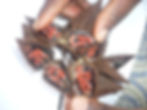Natural Dye experiments
Mekeka plait was originally plain and natural in colour, or patterned with some contrasting, plant-dyed palm. Palm leaves are quite resistant to most dyes - chemical or natural. Some natural dyes work well on palm however, such as annatto and turmeric, and various other plants dyes have been used effectively.
Annatto is know in some areas as the 'lipstick plant'; the way coated seeds are rubbed on lips and fingernails to give colour and used as an effective dye.
Palm leaves are dyed black with a combination of a grass locally known as muzukizi with iron rich mud that reacts with the tannin in the grass. Some groups still have the knowledge of how to make this dye, but an enormous amount of local knowledge of how to harvest and prepare natural dyes seems to have departed with an older generation of artisans.






Experiments with annatto on wild date palm and raphia palm leaves
My own attempts to identify local plant materials suitable for dyeing palm leaves, conducted with groups in the south-east of Uganda, produced disappointing results. Annatto provided the most definite colour - a bright orange - but the dyers tend to allow too little time for the dye to take, perhaps having become accustomed to using chemicals.
Late nineteenth century or early twentieth century missionaries first introduced chemical dyes to Uganda. Able to quickly dye natural fibres to bright, vibrant colours, they have been widely adopted. These chemical dyes are now sold in small, folded envelopes of recycled paper, with a daub of the dye solution on the outside to indicate colour, and are probably potentially toxic Basic or Azo dye. They are readily available from local markets, and today are used in preference to natural dyes, needing much less dyeing time and therefore less use of water and firewood. Ugandans love the bright colours that chemical dyes give.
The palm leaves are immersed in boiling water, in a large pot to which dye is added, and then simmered until they take up the required shade. Sometimes salt is added as a fixative, but not always; sometimes the palm leaves are soaked in water first, sometimes not. The first batch of leaves dyed in the pot tends to be stronger in colour than subsequent batches. Some plaiters embrace these variations by dyeing enough leaves for a whole mat in each batch, so that later batches offer paler shades to be used in other pattern making. As the dye solution may be used again and again until the colour is almost spent, the small quantities of effluence are likely to have limited negative environmental impact when they are tipped out.